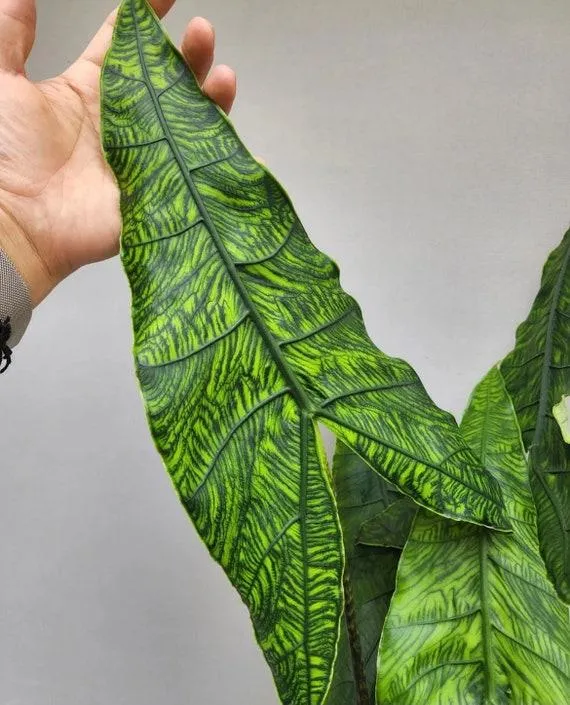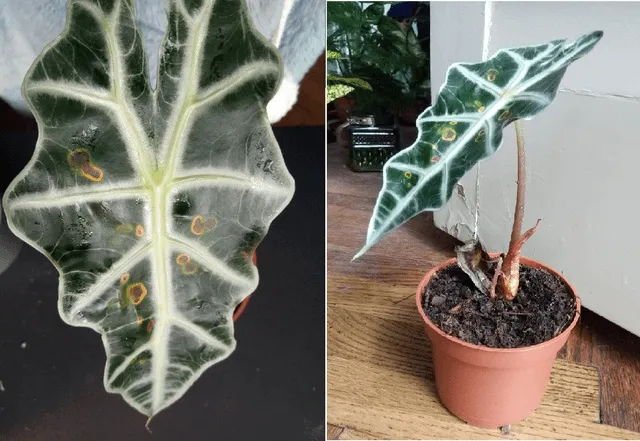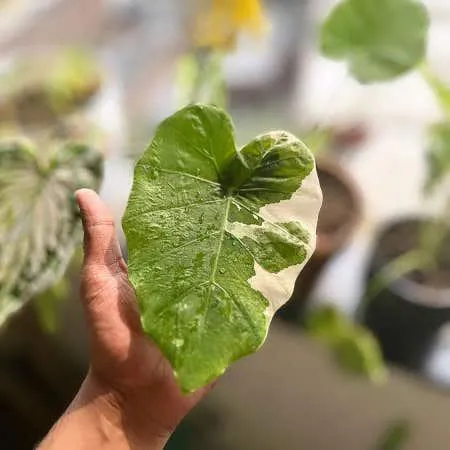Why Did My Alocasia Lose All Its Leaves and What Can I Do?
If you’ve found yourself in a situation where your alocasia plant has suddenly lost all of its leaves, you’re not alone. As the owner of over a dozen different alocasias, I’ve faced this before and learned a few things along the way. In this article, I’ll go over some of the most common reasons an alocasia might drop all its foliage and provide tips on how to care for a leafless plant.
Stress from a Change in Conditions
- Moving to a new location: From my experience, relocating an alocasia is a major stress that can cause a total leaf drop. Plants need time to adjust to changes in light levels, temperature fluctuations, and vapor pressure deficits in a new spot.
- Improper watering: Under- or overwatering are surefire ways to stress out an alocasia. Their rhizomes are very sensitive to soggy or dry soil.
- Sudden temperature change: Drastic swings in temperature, especially drops, can shock alocasias into shedding all leaves as a form of self-preservation. Their tropical origins make them dislike chilly conditions.
The good news is that if the plant is otherwise healthy, removing the stressor is usually all it takes to trigger new growth. Be patient—it may take a few months.
Pest or Disease Issues
Problems like root rot from soggy soil, aphid infestations, or fungal leaf spots creeping in are other common causes of a total leaf drop in alocasias. Here are some signs to watch out for:
- Blackened or mushy roots indicate root rot issues below the soil.
- Tinyinsects clustered on new growth or undersides of leaves point to an aphid problem.
- Yellow or brown spots on foliage that spread could mean a fungal disease like black leaf spot is taking hold.
If pests or plant pathogens are suspected, treat with appropriate remedies and improve care practices to get the alocasia healthy again.
Age and Natural Cycle Factors
On occasion, an alocasia may lose all leaves due to age-related decline or as part of its natural cycle. For example:

- Very old or root-bound specimens sometimes exhaust their stores and shed to start anew. Repotting with fresh soil could help rejuvenate it.
- Some varieties, like A. cuprea “Regal Shields”, are known to go completely dormant in winter—a surprise the first time! Just provide normal care and it may bounce back in spring.
So don’t panic if all else looks fine. The plant may just need time to reset itself.
Caring for a Leafless Alocasia
So now your alocasia is bare—but hope is not lost! Here are some tips on tending to a plant that’s lost its foliage:
Reduce water: Without leaves to transpire, cut back watering significantly to let the soil mostly dry between waterings. Overwatering can cause root rot during this vulnerable stage.
Adjust light: Move the plant to a spot with bright, indirect light. Too much direct sun can scorch new growth before it forms.
Check roots: Gently remove the plant from its pot and inspect roots. Remove any mushy or diseased parts with clean pruners.

Re-pot if needed: Repotting into fresh soil can give a boost. Be sure not to bury the rhizome too deep.
Fertilize sparingly: During dormancy, adding a diluted liquid fertilizer every few weeks provides nutrients for eventual regrowth.
Keep hopes up! It can take months for new sprouts to emerge, so don’t lose faith. As long as the rhizome is firm, regrowth should come.
With the right care and patience during this transition phase, there’s a good chance your formerly leafless alocasia will bounce back even stronger than before. The wait will hopefully be worth it!
Reader Questions
Hopefully this overview addressed the main intentions and questions of someone dealing with a seemingly doomed leafless alocasia. But feel free to ask if anything still has you puzzled:

- What should I do if the rhizome starts to mold or rot?
- Is it okay to repot before new growth appears?
- How can I prevent this from happening again in the future?
Don’t hesitate to reach out—part of gardening is learning from mistakes. With some TLC, your alocasia has a chance not just to survive but to thrive once more. Best of luck bringing it back to health!
Reasons Why Your Alocasia May Have Lost Its Leaves
| Reason | Details |
|---|---|
| Overwatering | Alocasias do not like soggy soil and will drop leaves if the soil stays too wet for too long. |
| Underwatering | Allowing the soil to dry out completely can also cause leaf drop as the plant goes into moisture stress. |
| Cold temperatures | Alocasias are tropical plants and dropping leaves is their response to temperatures below 65°F. |
| Poor drainage | Water must drain quickly from the soil to prevent root rot from overwatering. Use a pot with drainage holes. |
| Low humidity | Alocasias appreciate humid conditions of 50% or higher. Use a pebble tray or humidifier to boost humidity. |
| Pests or disease | Check for signs of pests like spider mites or disease like fungal leaf spot that can cause defoliation. |
FAQ
-
Why did my alocasia lose all its leaves?
There could be many possible causes for an alocasia dropping all its leaves. It might have been over- or underwatered, placed in too sunny or not sunny enough of a spot, repotted at the wrong time, or became stressed due to a change in temperature. Sometimes the plant is simply getting ready to go dormant for a bit too. So don’t panic!
-
When will it grow new leaves?
An alocasia may take several weeks or even months to push out fresh new leaves after losing its old ones. I guess you could say it’s sorta like when humans get sick – it takes time to recover. As long as the bulb and roots are still healthy, remain patient and give it optimal growing conditions. New growth should emerge before too long, maybe.
-
Can I save an alocasia that has no leaves?
There might be hope! As long as the bulb is firm and hasn’t gone mushy, it can possibly come back to life with a bit of TLC. Reduce watering for now. Move it to a spot with indirect light. Perhaps sprinkle a little fertilizer to perk it up. Lo and behold, small sprouts may start pushing through eventually. Crazy how resilient these plants can be, right?
-
How often should I water a leafless alocasia?
When an alocasia has dropped all its foliage, cut back on the H2O. Water just enough to keep the soil slightly moist – not soggy wet. Since there aren’t any leaves transpiring, less liquid is needed. Overwatering could cause root rot at this point. Better to err on the dry side than drown your plant friend while it’s in recovery mode. Play it safe!

On the other hand, some varieties of alocasia are seasonal shedders. Their leaves will disappear in winter or during a dormant period before bouncing back in spring or summer. This is normal behavior. Have faith that your plant isn’t a lost cause quite yet. Maybe check with a local plant expert or do some online research to figure out what type you have and learn its habits. With a little patience and TLC, hopefully those beautiful leaves will make a comeback before too much longer. Best of luck!
